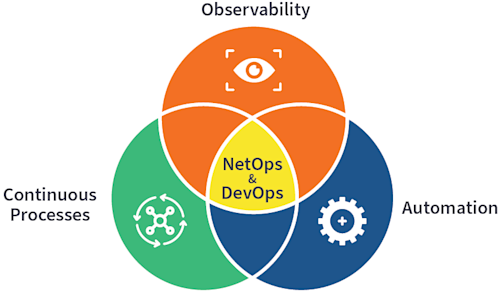What is NetOps? (Network Operations)
NetOps 2.0, defined
Under most definitions, NetOps (short for “network operations”) is a network operations strategy that focuses on maximizing agility, velocity and automation. It can encompass many roles, processes, and protocols within an organization’s network operation center, and serves to benefit employees and end users by delivering optimal network performance.
Some of the important tasks of Network Operations include:
- Network management and monitoring
- Network troubleshooting and updating of network elements
- Automating network configuration and remote access control
- Incident response
- Working with security teams to detect threats on the network
- Deploying and monitoring security tools in collaboration with security operations, such as an Intrusion Prevention System (IPS)
- Multipath WAN optimization
- Performance, quality, and optimization reporting
- Analytics and data collection to anticipate problems and ensure network resources are used efficiently
- Installing software or firmware for smooth transition of network changes
NetOps borrows from the philosophy of DevOps, which promotes similar goals in the realm of software development and delivery.
The multiple meanings of NetOps: NetOps vs. “NetOps 2.0”
Before diving into a longer definition of NetOps, it’s worth noting that the term can be used in two different ways:
Sometimes, NetOps is simply used as a shorthand for “network operations”—a generic term that refers to network deployment and management.
However, most people who employ the term NetOps today use it to refer to a specific approach to network operations that (as noted above) emphasizes agility, velocity and automation. This definition is sometimes labeled “NetOps 2.0” (or, more rarely, DevNetOps) in order to distinguish it from the other, more basic NetOps definition.
The transision from NetOps to NetOps 2.0
As organizations modernize their operations and software stack, DevOps technology has been increasingly advancing and enterprises are eager to adopt these new tools and practices.
Networks, on the other hand, have been slower to evolve. This is likely due to the highly complex nature of network infrastructures that involve a multitude of systems, devices, and protocols that are spread out across teams.
So while DevOps is helping to develop applications at an unprecedented rate, they cannot be readily deployed without the support of an agile, robust network. Therefore, NetOps 2.0 was created to be a catalyst in the relationship between the two ideologies so network teams and services could match the agility of DevOps.
NetOps and DevOps: similarities and differences
In most cases, NetOps refers to a network operations strategy that draws explicitly on the concepts, tools and strategies associated with DevOps. DevOps, which started to become popular around 2010 and is widely influential today, is a philosophy of software development and delivery that promotes collaboration between developers, IT operations teams and other stakeholders in order to streamline the process of creating, deploying and managing software. Similar to how DevOps was inspired by the automation and optimization process of the manufacturing industry, NetOps was inspired by DevOps

However, since DevOps focuses on software rather than networking resources, the extent to which the two concepts directly parallel each other is limited. Whereas DevOps focuses on application delivery and takes a risk-taking and iterative approach, NetOps prioritizes network performance along with uptime and minimizing risk, creating a natural conflict between the two. Additionally, most of the core tools of DevOps—such as source code managers, CI servers and release automation suites—don’t have a direct equivalent in the realm of NetOps.
However, there are certain key links between DevOps and NetOps, including:
- Automation: Both frameworks recommend that teams automate processes and systems
- Continuous processes: DevOps treats software delivery operations as a continuous loop in which teams plan, implement and release software, then collect feedback from the latest release to inform the next release cycle. Similarly, NetOps encourages teams to take a continuous approach to network operations by collecting feedback from one set of network changes to help plan the next round of updates.
- Observability: Observability, which means collecting external outputs to assess the internal state of a system, is important to both DevOps and NetOps because it allows teams to maintain visibility into their software delivery or networking operations. We call observability for NetOps network observability.
Benefits of NetOps
Compared to traditional network management strategies, which relied heavily on manual processes and provided little visibility into the state of the network, NetOps provides organizations with several key benefits.
First and foremost is the ability to create and manage agile networks that constantly change. NetOps makes it possible to maintain healthy network operations even as endpoints constantly come and go from the network, as VPN and VPC configurations are updated, as load balancers modify traffic patterns and so on. It would be very difficult to manage highly dynamic networks using a manual, low-visibility approach.
A second benefit of NetOps is the ability to make network changes more quickly using automated tools. For example, rather than requiring an engineer to reconfigure a firewall or routing table manually, a NetOps approach would typically entail the use of tools that can determine the optimal configuration based on the needs of the network, and (in many cases) implement it automatically. This type of network automation supports the continuous improvement of application delivery and services.
In addition, because NetOps treats network operations as a formal process that should be as structured and consistent as software development and delivery, it helps organizations to achieve greater predictability and reliability in operating their networks. Teams can plan changes to their networks. They can then validate those changes using network visualization and observability tools to catch configuration issues before changes are implemented. This enables the quicker deployment of network devices since they don’t need to be deployed as physical hardware within the network infrastructure.
Finally, they can continue to observe the network in real-time to detect problems that occur during live operations. With the use of tools such as network detection and response (NDR), this makes network troubleshooting much faster and easier.
NetOps as a philosophy
Although NetOps encourages certain practices and strategies, it’s important to understand that NetOps is not a rigid set of processes or tools. Like DevOps, it’s a philosophy that makes high-level recommendations about how teams should approach their operations, and what they should prioritize. Each organization is free to choose the exact tools and processes that it uses to achieve the goals of NetOps.


